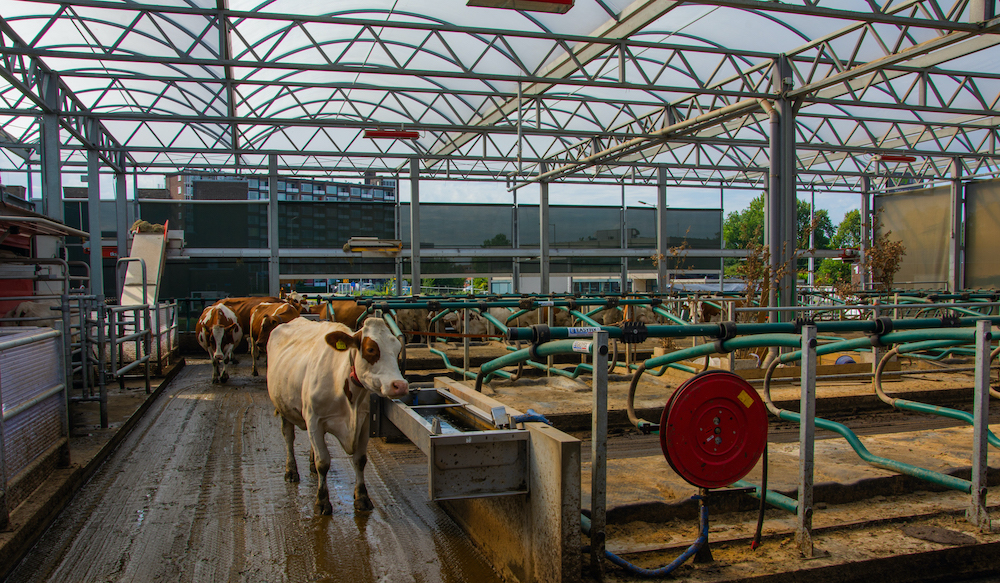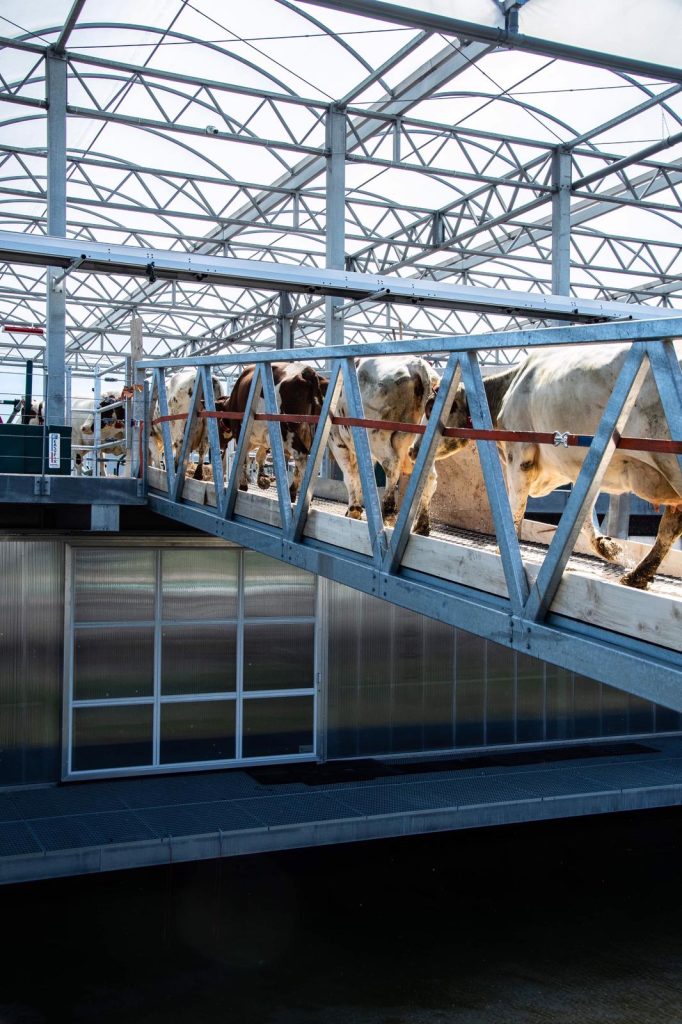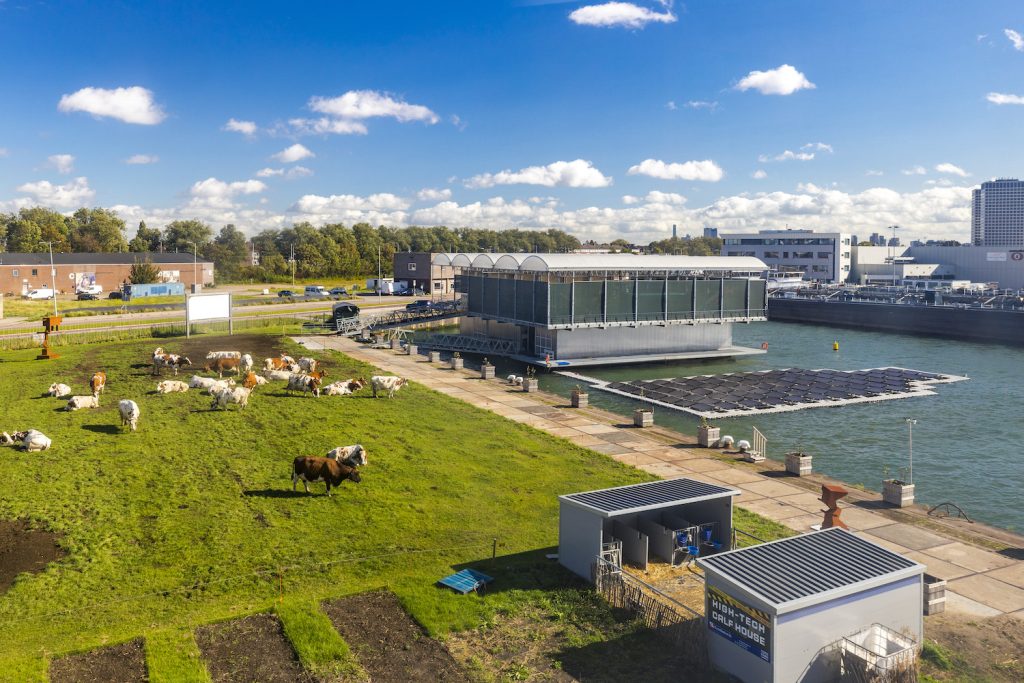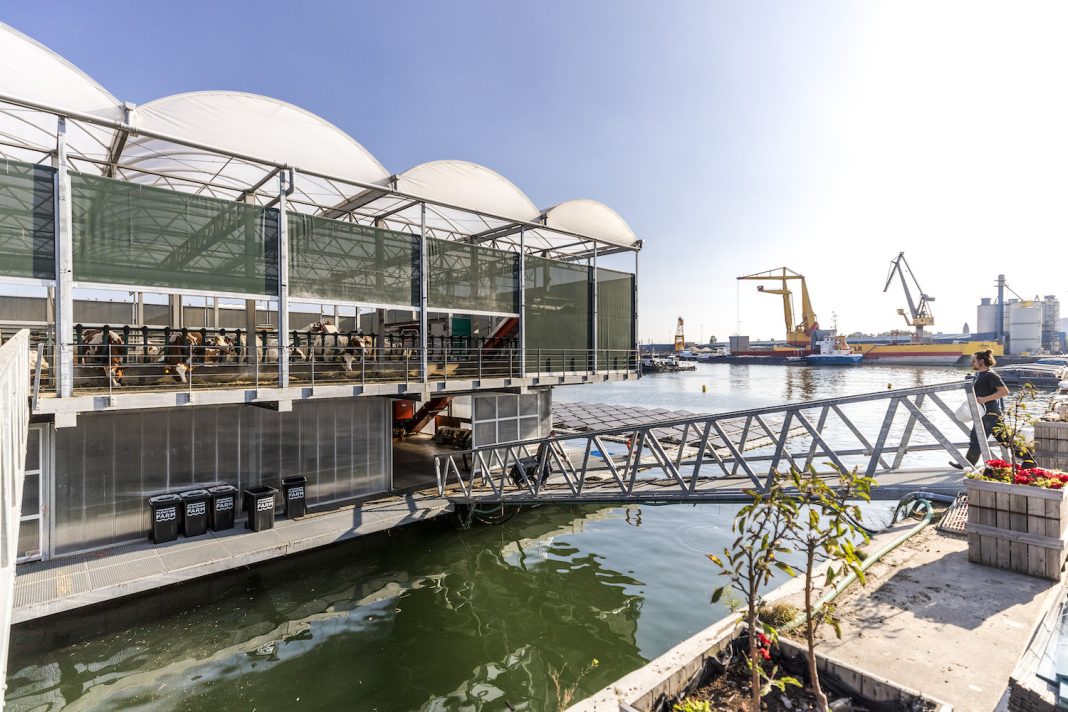Space in cities is limited. Urban farming signals better times for food security but if there’s a future in it, we need to find ways to make it fit around existing land uses. When room on rooftops runs out, then what? Rotterdam’s floating dairy farm is an example making use of untapped real estate – right on the surface of a river. How it really earns its place in the city, though, is that it serves the most deserving communities first.
Hurricane Sandy caused $70 billion USD in damages when it made landfall in the Caribbean and USA on 24 October 2012.
As a coastal city, New York city was badly flooded, affecting 90,000 buildings and leading to 46 of the 200+ recorded deaths; many thousands of people were left without power for light, heat, and hot water.
At the time, Peter van Wingerden was in NYC working on a project to establish a neighbourhood of floating houses. It’s somewhat ironic given his native Rotterdam, Netherlands, is well known for exactly that.
He witnessed first-hand how, within just a few days, fresh food disappeared from the shelves. Infrastructure had broken down under the volume of water, preventing supplies from being replenished.
Urban Farming As Disaster Relief
It’s a strong argument in favour of urban farming to reinforce food security. As it gains momentum, we’re quite used to seeing green spaces doubling up as community gardens or allotments, or heading up on the roof to grow on formerly underused space. But in a flood, these too would be swept away.
And if predictions are to be believed, only 3% of our food could be grown via urban agriculture in the near future. Maximising the use of available space for farming is an imperative, and rivers are vacant space that cities would be wise to exploit.
This gave Peter a lightbulb moment, explains his business and life partner, Minke van Wingerden: “If we can make houses on the water, why not make a farm on the water? Because then you can keep producing fresh, healthy food for the city, even when there is a flood.”
Food Security & Rotterdam’s Floating Farm
Now back in Rotterdam, that’s exactly what the couple have done: the van Wingerden’s built the world’s first floating dairy farm.
It’s a three-storey vessel with a floor area measuring 27×27 metres anchored to the shore of the Nieuwe Maas tidal river that bisects the city.
It makes efficient use of the space, too. It’s home to about 40 cows, which live on the top of three floors and produce approximately 800 litres of milk each day.
The next level down houses an automated manure processing plant which recycles bovine effluence into organic fertiliser, which is in high demand among local plant and vegetable growers.
Alongside the flotation device, the bottom storey – which is underwater and so remains at a consistent level of heat and humidity – has multiple uses:
- To grow microgreens, leafy veggies, and herbs.
- For ripening cheese.
- Testing the potential for desalinating brackish port water using heat from the manure.
About 45% of the energy that powers the farm is generated by solar panels that float nearby – amusingly set in the shape of a milk bottle.
An Environmental Enterprise
Bringing a dairy into the city may seem outlandish, but there’s a lot of sense to the idea for cities looking for ways to tighten food security. Enabling production close to home relieves urban reliance upon rural communities and long, fragile supply lines.
Impressive enough, but there’s more.
“I see more and more that people hardly know how to prepare a meal by themselves,” Minke observes. “That worries me. A city needs projects like this to make it easier for children to stand next to a cow or realise where does the milk come from. We always tell them it costs a lot of love and energy for the farmer and for the cow to give us our daily glass of milk.”
That’s why the floating farm doubles up as an educational centre, creating awareness about healthy eating and how food is produced.
It’s really important that people know what their body needs to eat.

But in an intimate farm in the city, compared with industrial farm in the countryside, there’s a chance to do things differently.
Circularity was designed into the farm from the start, ingratiating it into Rotterdam’s business ecosystem.
Minke explains how the cows eat unwanted byproducts sourced nearby. Besides grass cuttings, they get beer broth from a neighbouring brewery, peel from Rotterdam’s fresh orange juice supermarkets, and even leftovers from bakeries and food banks.
By making use of Rotterdam’s food waste, the farm acts as a kind of carbon sink for the city. Plus, producing goods close to market and removing the need to bring in cattle feed from beyond the city boundaries minimises food miles, lowering transport emissions.
“We would not like to buy corn or soy from far away,” Minke tells us. “That is why we call our cows ‘up-cycle ladies’, because they up-cycle the residual products from the city.”
Cows, Challenges & Community
Of course, bringing 40 cows to live permanently into the city doesn’t come without its critics. “People prefer Chanel number 5 instead of the odour of cows,” Minke quips.
That’s dealt with swifty. An automated machine extracts urine from the manure. “If you do that within three hours, you have 60 percent less emissions, but also less odour.”
Then there’s the matter of animal welfare.
Minke is very matter of fact about this, as farmers tend to be. She says that activists “are against [dairy farming] in general”. That’s the point she wants to emphasise: this is no different to a regular dairy, except that it’s on the water.
Except, that is, that “our cows have one and a half more square meters to move than in a regular farm”.
The farm’s website states that they have individual beds that can even “be adapted to individual wishes and desires for each cow” and they “determine when they want to be milked by choosing to go to a milking robot”.
The cows can even access a meadow for grazing and a ‘playground’ on shore via a ramp at almost any time they choose. “But now [in summer] it’s too hot, so they prefer to stay in the shed, because there’s always a wind, and they like that.”
Our cows can walk in or out freely.
Milk Shake-ups

The only time the ramp is closed off – for the cows’ safety – is during a storm. Generally, the farm has proved to be stable, despite rising and lowering two metres with the tide each day. Even a wild storm in 2021 did little to upend it.
One cow has fallen into the river, but they are known to do this from conventional fields so not seen as a unique cause for concern relating to the floating farm.
The biggest structural concern is actually weight distribution.
“Cows are very curious. They flock together, so they go from one side of the farm to the other,” Minke explains.
As the average Maas-Rijn-Ijssel cow comes in at about 850 kg, that’s a lot of weight concentrated on one side, but even this doesn’t threaten to capsize the vessel. “You cannot feel it. It’s very, very stable.”
Food Brings People Together
The farm is moored on a patch of the quay, which the van Wingerdens rent from the port authorities, close to Schiedam, “a relatively poor village,” Minke tells us.
Food-related challenges there run deep. “People hardly know what their bodies need,” Minke explains, adding that even if they do, “they can hardly afford it”. It’s a typical tale for low-income neighbourhoods, where people are less likely to eat well.
Having a farm on the doorstep that sells direct to market is a big reason why this area hasn’t become a food desert – a phenomenon that the van Wingerdens witnessed so much of in the USA.
But dairy wasn’t the original objective for the farm. It turns out that way as Peter happened to meet someone developing new floors for cows at the same time, and they teamed up to work on their developments.
Minke was all for it, realising that this would suit the diverse cultural makeup of Schiedam: “My idea was right from the start, that we should sell raw milk, because I know that people here have a lot of old recipes to make their own cheese, yogurt, or whatever.” It’s a bonus that the food is such good quality.
Our products are so pure; they cannot buy the same in the supermarket.
This was instrumental to engaging the local community, which grew organically. The popular shop and volunteering opportunities on the farm have made it a lively community hub, where locals meet up, converse, and share their culinary traditions.
“I love the stories people like to share on the terrace. Food brings people together.”
Floating an Idea: Building the First Floating Farm
It was almost never the case. The city took a lot of persuading before they’d issue a permit for the farm.
“We had to prove cows would not get seasick.”
What at first seemed an unrealistic ask was made possible thanks to an age-old solution: calling in the cavalry. In this case, it was the University of Utrecht.
After a lot of head scratching, they came to a sensible resolution. “There are a lot of carriers who go around the world with cattle, and we are okay with that, so why not be okay with a floating farm?”
Urban Farms of the Future
Peter, Minke, chief farmer at the time, Albert Boersen, and an architect worked together to formulate a design that suits the needs of the dairy.
What they have now serves as a reliable prototype, although future designs will be different.
“We learnt a lot”, Minke admits of the trial-and-error nature of building the concept from scratch. “It’s the same when you build your own first house.”
This explains why Minke still refers to it as a “research project”, but they’re not looking to make a one-size-fits-all template.
They are looking to take the floating farm to countries that stand to gain a lot from it, our CityChanger explains; particularly Singapore, Japan, and Korea, which “import over 90 percent of all their food, and they are surrounded by water”.
That is our dream to make things happen all over the world and that people see the social impact of it.
They also have plans to expand in purpose-built chicken and goat farms – maybe even cultivating seaweed: “I think that is also a bright future.”
Initial feasibility studies have proven that conditions and demands in every city are different, so having a modular design where elements can be hand-picked and assembled in different ways to suit local conditions will make it attractive – and potentially much quicker and cheaper than a complete redesign each time.

Making More Milk Thank Money
It will be up to Minke and her background in communications to lead this side of the business, but she has a head start.
Our CityChanger tells of how interest in the floating farm exploded to such an extent after the first article about it was published in 2016 that it was difficult to field all the calls and emails.
They still give tours to “about 60 groups a month from all over the world”. This level of interest “really helps us to make a better business case,” Minke explains.
That’s majorly important because investors tend to look solely at economic gains and on this small scale, the dairy is hardly profitable. “That is why upscaling must be done. And it can easily be done,” our CityChanger expresses.
In the meantime, the dairy relies on about 40 volunteers who help run the farm shop, give presentations, take care of deliveries, etc.
“People feel part of… they call it the floating farm family,” Minke says.
I like to make people aware of the social benefits. If it was possible to make that clear in figures, then I think everybody would invest.
That’s why the couple must retain their focus on why it is they established the farm in the first place: “We do this not because we want to make a lot of money, we do it because of our grandchildren. They need a better world, and we do it right from our heart. I think that touches people.”
Will Urban Farms Thrive?
And sometimes it leads to new opportunities, like it has in Chicago.
Peter and Minke were approached by the city to help repurpose a vacant office building into a vertical farm.
While not a floating farm, it makes use of much of the knowledge they have gained and has similar objectives: to provide citizens with locally grown, healthy food and educate them about alternative food systems.
“It gives us a lot of energy because people are so open and willing to make things happen.”
Meanwhile, the long-term future of the floating farm in Rotterdam is in doubt.
This part of the quay is earmarked for new development. Workplaces and residential blocks are arguably more lucrative for the city than farming, so the van Wingerdens may find themselves pushed out after their 10-year lease expires.
Given what the farm has done for the local neighbourhood, this seems short sighted. For that very reason, the local authorities might have a fight on their hands.
“Now, if there are some people against us, they shout loud and clear: we are so proud to have you here and we love your products.”
We can only hope that it doesn’t take another disaster for the city to realise how important initiatives that increase food security are. But if it happens, the floating farm family and their happy cows will be prepared.


